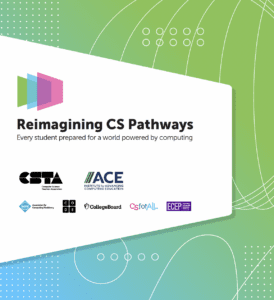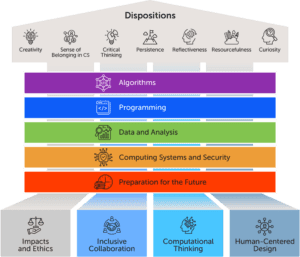
In a world increasingly powered by computing, students of all identities and chosen career paths need quality CS education to become informed citizens and confident creators of content and digital tools. The Reimagining CS report defines community consensus of the computer science content that all high school students need to learn, as well as pathways for continued learning. Read the report at ReimaginingCS.org.
The Need to Reimagine CS
As society continues to increasingly rely on computing technologies, the need for early, universal CS education will only become more important. There are a number of other key factors necessitating the reimagining of computer science (CS) education:
- More students than ever are learning computer science, and states are increasingly adopting high school graduation requirements in CS, which will lead to burgeoning participation.
- These students are more diverse and have greater experience. Yet, there are persistent inequities in access, participation, and engagement in CS.
- The CSTA standards haven’t been updated since 2017, but there have been significant advances in computing, including artificial intelligence (AI), data science, and cybersecurity.
- Research has evolved, with far more evidence to inform how students learn CS.
Project Overview

In response, CSTA and the Institute for Advancing Computing Education (IACE) co-led an equity-centered, community-wide project that explored how CS learning opportunities can be reenvisioned for high school students. Working in partnership with ACM, Code.org, College Board, CSforALL, and ECEP Alliance, we developed community consensus to answer two key questions:
- What CS content is essential for all high school graduates to know?
- What pathways should exist to continue learning beyond the foundational high school content?
We achieved this community consensus by gathering experts representing K-12, higher education, and industry across the U.S., synthesizing trends and comparing with the latest research, and soliciting feedback from more than 100 people.
This project recently published a report that included many important outputs:
- Recommendations on the foundational content that should be included in courses or experiences satisfying a high school graduation requirement;
- Examples of high school CS pathways that extend beyond the foundational content;
- Guidance for implementation of these pathways and how to integrate CS content into other subject areas; and
- A framework that enables a systematic and deliberate process for examining and re-creating similar pathways in the future.
These outputs will directly inform the CSTA K-12 Standards revision, as well as future updates to Advanced Placement CS courses.
A Preview of the Foundation

We organized community consensus defining what all students need to learn as part of a foundational CS learning experience in K-12 in the figure shown below. Across the bottom, four Pillars are highlighted as critical to all CS instruction; these practices, methods, and approaches are: (1) Impacts and Ethics, (2) Inclusive Collaboration, (3), Computational Thinking, and (4) Human- Centered Design. Shown in the colored bars in the center, there are five Topic Areas organizing detailed learning outcomes: (1) Algorithms, (2) Programming, (3) Data and Analysis, (4) Computing Systems and Security, and (5) Preparation for the Future. And listed at the top of the figure are seven prioritized dispositions we seek to foster in CS: creativity and sense of belonging, which are interrelated, plus habits of mind related to self-regulated learning, including critical thinking, persistence, reflectiveness, resourcefulness, and curiosity.
Much of this content intentionally matches the organization of the current CSTA K-12 Standards, in order to build off of current implementation efforts. However, some notable priorities and distinctions of the Reimagining CS foundation are:

- Social Impacts and Ethics was identified as the highest priority. As a result, we defined it as a Pillar to stress the importance of intentionally integrating throughout all CS learning.
- Algorithms and Programming continued to be important and were, in fact, given greater attention as separate topic areas. Even in an age of AI, programming continues to be a foundational topic area; however, specific learning objectives will evolve, such as an emphasis on reading, writing, and revising code. Additionally, there is a greater emphasis on algorithms and computational thinking relative to what is typically taught today.
- There is a strong emphasis on Data and Analysis, reflecting the increased prevalence of data in daily aspects of life as well as the vast amount of data upon which AI technologies are built.
- The importance of AI is reflected in essential content organized across multiple Topic Areas, which also reinforces the need for some durable knowledge and skills.
- There is a need to connect CS learning to careers across all disciplines that will increasingly leverage computing, plus anticipate the need to teach about future advances in computing. Related learning outcomes are organized in Preparation for the Future.
See Foundational Content for detailed learning outcomes, descriptions, and examples of integrating the Pillars and Dispositions.
Revising the CSTA K-12 Standards
This foundational content, plus learning progressions for specialty areas (see Pathways), will directly inform the revision of the CSTA K-12 Computer Science Standards. We are currently one year into a comprehensive, three-year process that will result in a thoughtful, comprehensive, and evidence-based revision to these standards. The process is taking place across three stages: (1) Research, (2) Writing, and (3) Implementation, as summarized in the following timeline:

Our impressive, educator-led writing team kicked off their work last month and will meet regularly across the next two years. They will use the Reimagining CS report to guide revisions, along with other research and community feedback. Since the foundational content defines end-of-high school learning outcomes, writers will work to backwards map progressive learning outcomes across grades K-12 to create coherent, vertical alignment. They will also work to refine priorities and ensure that the standards are clear, rigorous, informed by evidence, measurable, and flexible in their implementation. We will publish the updated standards in summer 2026.
Conclusion
I am inspired by considering what is possible when every student learns the essential content outlined in the Reimagining CS foundation. Some of the seemingly intractable problems of our current and future generations may be tackled by the very students who sit in the classrooms today learning the future of technology and weighing its ethical implications. I am hopeful that by arming them with a strong foundation in CS, we will develop a well-informed citizenry who not only understands but also carefully considers the impact of computing technologies and successfully disrupts the persistent inequities we see today.
Realizing this vision will require sustained effort across a community-wide effort. Please support us in Reimagining CS by sharing the report and advocating for these recommendations.
Acknowledgments
Reimagining CS Pathways was co-led by CSTA and IACE, in partnership with ACM, Code.org, College Board, CSforALL, and ECEP Alliance. We acknowledge the many participants who added valuable insights to the project via convenings, focus groups, and interviews. These contributors include those who had recently completed high school, high school teachers, higher education faculty, and those who work in tech-related industry positions. We also thank many asynchronous reviewers, guest speakers, National Science Foundation contributors, staff support, and accessibility review from the DO-IT Center. This project is supported by the National Science Foundation (NSF) under Grant No. 2311746. Any opinions, findings, and conclusions or recommendations expressed in this material are those of the author(s) and do not necessarily reflect the views of the NSF.

